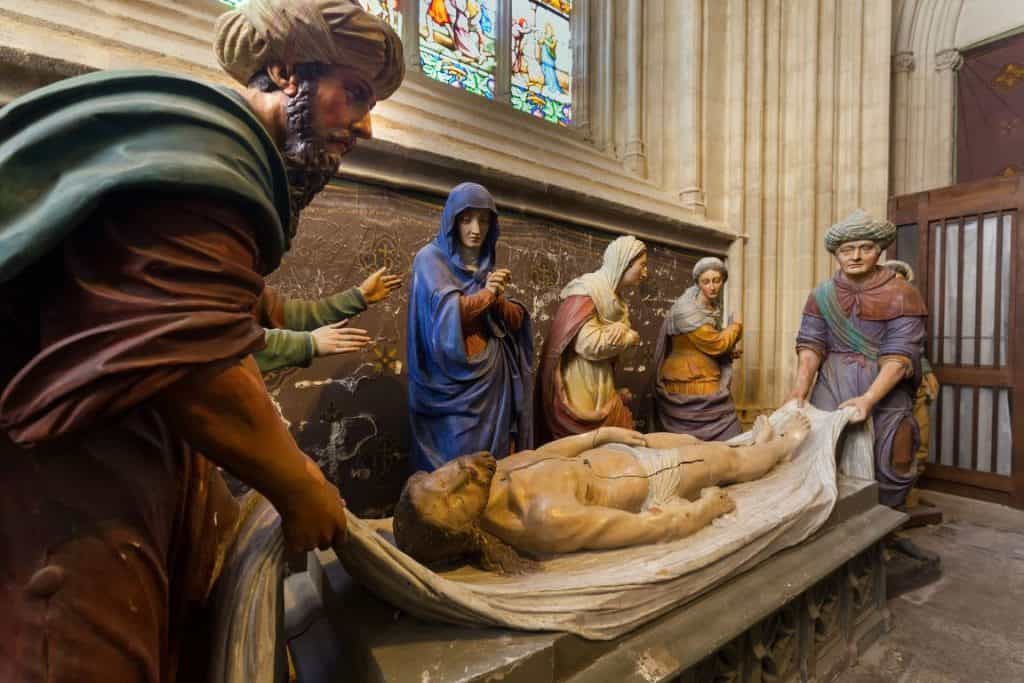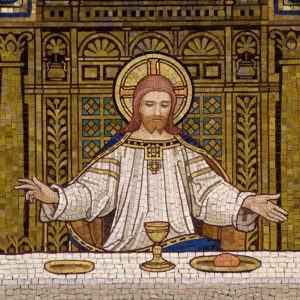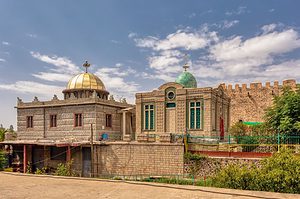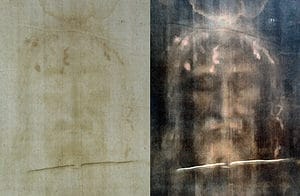The history of the Shroud of Turin is controversial. Officially, the shroud first appears in 1350 in the French town of Lirey. A French knight named Geoffroi de Charny is said to have offered it to the Dean of the church in Lirey as the authentic shroud of Jesus. This official version does not disclose how de Charny obtained the shroud or where it was located in the 1,300 years since Christ’s burial outside Jerusalem.
Ian Wilson, however, makes it plausible that the shroud was described much earlier as the Cloth of Edessa. He suggests that this Cloth ended up in Constantinople and was brought to Lirey by the Knights Templar. The journey of the Shroud can be seen on the map below.
What is the Shroud of Turin?
The Shroud of Turin is a linen cloth measuring over four meters long with a mysterious and blurred image of a man who was tortured and crucified. Since the Middle Ages, this cloth has been worshipped as the burial cloth of Christ. This cloth, according to the Gospel of John, had been left in the tomb after Jesus rose from the dead.
The shroud in Jerusalem
Officially the Shroud of Turin can be traced back to its first exposition in 1355 in Lirey (France). But for this reconstruction, we will assume that the Shroud of Turin is actually the Burial Robe of Jesus.
With this premise, we can pick up the journey of the shroud after the crucifixion of Christ. We will proceed to the moment when John and Peter enter the tomb of Jesus and discover that Jesus’ body has disappeared and the shrouds have been left behind. John writes about what he calls a Sudarion (sweatcloth), which has been rolled up and set aside:
He entered the tomb and saw the linen cloths lying there. The cloth that had been around Jesus’ head was rolled up, lying separate from the linen cloths.
Johannes 20:6-7

The history of the shroud in Edessa
A disciple of Jesus, named Thadeus or Addai, traveled from Jerusalem to Edessa (Urfa, Turkey) at the invitation of its ruler, Abgar V.
Reports from that time describe that Abgar, thanks to Thadeus, was cured of a disease, and many people in Edessa converted to Christianity.
Thadeus, according to some writings, is said to have carried with him a cloth miraculously imprinted with the likeness of Jesus.

After the death of Agbar V, a number of his successors turned their back on Christianity. The cloth was hidden, presumably above one of the gates of Edessa. Several chronicles from this period describe how Christianity was alternately professed and reviled in Edessa. The shroud was not mentioned anymore.
Then in 525 a terrible disaster took place. About 30,000 people died in a great flood. Edessa was largely destroyed. Then one of the chronicles reported that during the restorations, a cloth with the image of Jesus had been discovered above the West Gate of the city.
The historian Evagrius described that during a siege the city was protected by a cloth with a “divinely wrought image (theoteukon eikona), which was not made by human hands“. According to Wilson, this description is consistent with the Shroud of Turin.
In the Acts of Thaddeus, the cloth is described as the one on which Jesus had wiped his face. The cloth was folded in quarters, suggesting that the cloth of Edessa must have been quite large.
In 692, coins were minted with the likeness of Christ. The representation corresponded to the head on the cloth.
However, when in a later period, under the influence of the Muslims, all kinds of relics and icons were destroyed, the cloth was spared “because its imprint had not been made by artists.”
The shroud in Constantinople
When Edessa was besieged by the Byzantines in 943, they were compelled to hand over the cloth to the Byzantine Emperor Romanus. In exchange, 12,000 pieces of silver were paid and 200 Muslims were released. Edessa was also promised never again to be attacked by the Byzantines.
The shroud arrives in Constantinople on Aug. 15, 944. The next day the cloth was carried around in procession. On that occasion the Archdeacon of Constantinople gave a speech where he stated that the imprint included the blood of the Passion and therefore must have been made after Jesus was taken down from the cross.
Under Constantine’s direction, the history of the Shroud is recorded in the “Narratio De Imagine Edessena“. Later, the cloth would be named “the holy Mandylion.”
From then on, the cloth of Edessa is described by several people as the Burial Robe of Christ, showing the whole body of Jesus. On the other hand, most paintings only showed the head.

Around 1200, during the time of the Crusades, the cloth disappeared again. Theodore wrote an angry letter to the pope stating that French looters had stolen “the linen in which our Lord Jesus was wrapped” and taken it to Athens. A name was mentioned: Ortho De La Roche, who later became a Magister in the Order of the Knights Templar (you will come across the name De La Roche again several centuries later in relation to the Shroud of Turin).

The Knights Templar and the Holy Grail
The relationship between the Knights Templar and the Holy Grail may be far-fetched, but historically, you can certainly relate the grail writers to the temple knights.
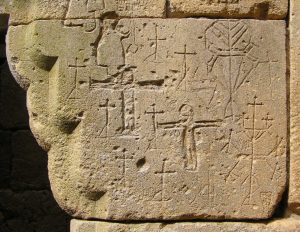
Knights Templar Art – Mysterious Templar Graffiti in Domme
The Knights Templar art (the graffiti of the templars) refers to the images the Knights Templar carved into the walls of their dungeon in Domme
The Knights Templar and the Shroud of Turin
Between 1200 and 1357, the shroud had disappeared. Neither the Shroud of Edessa nor the Holy Mandylion was mentioned anymore. However, the Knights Templar were accused of worshiping a bearded head, also called the head of Baphomet. Baphomet is said to be a corruption of Muhammad, so it was assumed (incorrectly, by the way) that the Templar had converted to Islam.
Another explanation could be that they possessed the shroud and folded it in such a way that only the head was visible. If true, it would have ended up in Acre. After the Siege of Acre, the Templar treasure was taken to Cyprus and then transported to France in 1306 by the Grand Master of the Templars, Jaques de Molay.
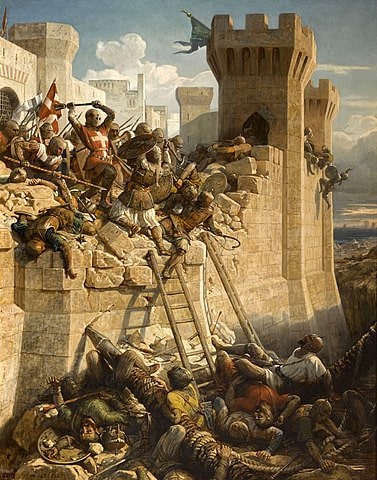
A year later, on Oct. 13, 1307, the Knights Templar would be arrested. The King of France, Philip IV, made short work of this order, to whom he owed a lot of money. He was hoping to seize the legendary treasures of the Templars, but did not know that these treasures had left the country a day earlier.
A few years later, after a period of intense torture, Jacques de Molay was burned to death in the square in front of Notre Dame in Paris, a fate he shared with Godfrey de Charny ánd that name, too, you must remember because….
The history of the shroud of Turin in Lirey
In 1353, the French knight Godfrey de Charny (a namesake, thus perhaps the (grand)son of…) received money from King John the Good to found a church in Lirey, near Troyes.
He was an heroic knight and a personal friend of the king. He was made a member of the Order of the Star, founded by King John the Good modeled after the Order of the Knights Templar. Godfried de Charny was the owner of what is now known as the Shroud of Turin. It is not known how he obtained it.
In 1355 there was an exhibition of the shroud! This much to the anger of the Bishop of Troyes. Possibly the little town of Lirey was making too much money from the pilgrims who came to see the cloth. In 1356, Godfrey de Charny dies, and the cloth is concealed again. De Charny’s body is reburied in Paris, where it “was united” with the heart of King John the Good.
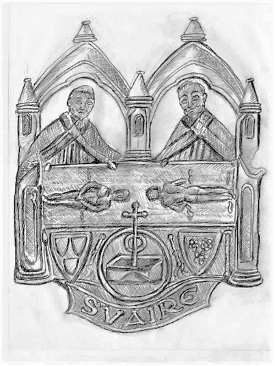
The unjustified exhibition of the cloth was written in the Memorandium of Bishop d’Arcis, who was a fierce opponent of Godfrey de Charny. It is unknown why this bishop wrote a letter to the Pope in 1389 stating the cloth was not the real shroud. D’Arcis even reports that he knew the artist who created the cloth. It is this Memorandium that is still quoted today by people who believe the shroud is a fraud.
Perhaps the intent was the Bishop confiscating the shroud. He wanted to house it in some other church in Troyes. This failed, and in January d’Arcis received a letter from the Pope telling him to leave the shroud alone. The Pope let Charny’s son (Godfrey II de Charny) know the conditions he had to meet in order to be exhibited again in Lirey.
After the death of Godfrey II in 1400, his wife Margaretha de Charny remarried Humburt of Villersexel, Count de la Roche. Humburt is probably a descendant of Ortho de La Roche, who had stolen the canvas from Constantinople.
Fearing looting, the shroud is given to de la Roche for safe keeping. The shroud is housed in St- Hyppolyte sur Doubs, where, according to chroniclers, it was exhibited annually.
Humburt died in 1338. From 1449, Margaret de Charny traveled around with the shroud. In 1449 it was exhibited in Chimay and in 1452 in Germolles near Chalon sur Saone. In 1453, the cloth was given to Duke Louis I of Savoy.
The Shroud in Chambéry
The shroud frequently accompanied by Louis I as he traveled from court to court. Meanwhile, the cloth was also regularly displayed. It was not until 1502 that the shroud was finally transferred to the royal chapel at Chambéry. It was placed behind the main altar, behind an iron gate. The gate had four keys, two of them were in the possession of the duke and the other two were kept in the chapel.
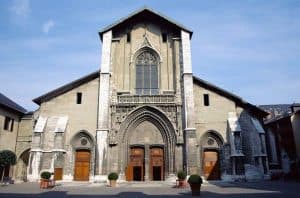
In his book, Wilson gives a detailed account of the ups and downs of the shroud, which continued to change places (courts) regularly in the years that followed. But when the shroud was back in Chambéry in 1532, disaster struck. A fierce fire broke out and, due to the security, the gate behind which the shroud was stored could not be opened. The beautiful relic case partially melted before the local blacksmith could break open the gate.
The shroud, partially on fire from a drop of silver, was put into water. This blaze is responsible for the scorch marks and water damage on the sides of the cloth. As if by a miracle, the actual image is spared.
Finally, the shroud was repaired by the sisters from the Clarissen convent.
Then the war with the English broke out. The shroud was temporarily taken to Italy for safekeeping and exhibited in Milan and Turin. In 1568 – by order of the Pope – several copies of the shroud are made.
And finally: the Shroud in Turin
In 1578, the Shroud was definitely taken to Turin. Since the 17th century, the shroud has been displayed in a chapel built by Guarino Guarini for that purpose. In 1694 Sebastian Valfrè made improvements to earlier repairs. Princess Maria Clotilde of Savoy had the cloth repaired again in 1868.

The shroud remained the property of the House of Savoy until 1983, when Umberto II of Italy donated it to the Holy See. As with all such relics, the Roman Catholic Church made no claims about its authenticity. According to the Church, the authenticity of the garment has no bearing on the truthfulness of Jesus’ teachings or the evidence of his death and resurrection.
A fierce fire broke out on April 11, 1997, believed to be the result of arson. The Shroud was restored in 2002. The cloth that had been applied to the reverse side was removed. For the first time, the back of the cloth was scanned. Here, too, a vague image of the body could be seen.
In 2010, the Shroud was exhibited in Turin. It was visited by 2 million people. It is possible that the cloth will be exhibited again in 2025.
Controversies and academic research
The shroud is the subject of scientific research. In 1978, a team of experts was allowed to investigate for 5 days. Their conclusion was that the Shroud really had to be the burial cloth of Jesus.
In 1988, a C14 investigation was conducted, characterized from the beginning by mutual quarrels. Eventually the results would leak out prematurely, much to the anger of the Vatican. When a photograph shows the three delegates from the scientific institutes sitting complacently in front of a blackboard with the dates 1260-1390!, it started a robust counter-investigation. This new research shows that mistakes were made.
Abbé de Nantes and Brother Bruno talk about the greatest scientific crime of the twentieth century. Joseph Marino discusses this at length in his book The 1988 C-14 Dating Of The Shroud Of Turin: A Stunning Exposé from 2020.

In 2022, Dr. Liberato de Caro, a member of the Italian National Research Council, used a new X-ray technique designed specifically for dating linen.
He used a method known as wide-angle X-ray scattering (WAXS), which he said is more reliable than carbon dating. He said this is because carbon dating can be dramatically wrong due to contamination of the object being dated. According to his research, the cloth must date from the time of Christ.

